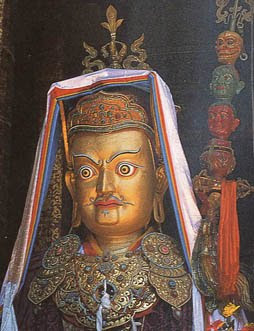Tradition records that a Tantric tradition "Buddha" named Padmasambhava came from a land called Ögyen [Shambala?].
This is thought to be somewhere in the wild remoteness of the Karakoram mountains, where India, Pakistan, Afghanistan, Russia, and Tibet meet.
Buddhism reached the height of its influence in the 8th and 9th centuries in Afghanistan [likely the Buddha's actual birthplace, once the northwest frontier of greater India].
This is thought to be somewhere in the wild remoteness of the Karakoram mountains, where India, Pakistan, Afghanistan, Russia, and Tibet meet.
Buddhism reached the height of its influence in the 8th and 9th centuries in Afghanistan [likely the Buddha's actual birthplace, once the northwest frontier of greater India].
Then Afghanistan fell to the Arabs [Zoroastrianism and Islam from neighboring Persia/Iran]. Most of Afghanistan's Buddhist heritage survived intact until quite recently. Although the site was destroyed by Genghis Khan in 1222, the towering statues remained as a strong indication of what had been. More
-
PADMASAMBHAVA (Sanskrit, Padmakara; Tibetan, པདྨ་འབྱུང་གནས།, Mongoloian ловон Бадмажунай; Chinese, 蓮華生) means "The Lotus-Born." He was a sage guru from Oddiyāna, who is said to have transmitted Vajrayana Buddhism to Himalayan Buddhist kingdoms Bhutan, Tibet, and neighboring countries in the 8th century. In those lands he is better known as Guru Rinpoche ("Precious Guru") or Lopon Rinpoche, or simply Padum in Tibet, where followers of the Nyingma school regard him as the second buddha. He said: "My father is the intrinsic awareness, Samantabhadra (Tibetan, ཀུན་ཏུ་བཟང་པོ). My mother is the ultimate sphere of reality, Samantabhadri (ཀུན་ཏུ་བཟང་མོ). I belong to the caste of non-duality of the sphere of awareness. My name is the Glorious Lotus-Born. I am from the unborn sphere of all phenomena. I consume concepts of duality as my diet. I act in the way of the buddhas of the three times [past, present, and future]."
"Buddha"?
Wisdom Quarterly (ANALYSIS)
Wisdom Quarterly (ANALYSIS)
The word "buddha" is used very loosely in schools and traditions that came after the earlier Theravada school. Originally, the word ("Awakened One") referred to the historical Buddha Shakyamuni (Siddhartha Gautama) and 24 previous buddhas he named and gave the history for. This was taken and blended with Vedic Brahmanism (which later became Hinduism) to develop the Mahayana view of an infinite number of "buddhas" just as there are countless manifestations and incarnations of God (Brahman). Padmasambhava, possibly a missionary, guru, conqueror, ruler, space entity, deva, or possibly a political personage came to be called a buddha probably as a honorific title. Thereafter, a mythology sprung up around him to spread Vajrayana teachings about reality (phenomena) and spirituality (non-duality).
Padmasambhava I: the Early Sources Known as Pema Jungné ("the lotus-born") or Guru Rinpoche ("the precious guru") in Tibet, Padmasambhava is seen as the true founder of Tibetan Buddhism [Vajrayana, Lamaism, Mahayana], a second buddha who established the Dharma in the land of the red-faced men. Padmasambhava is said to have been invited to Tibet to help found the first Tibetan Buddhist monastery, Samyé and tame the local demonic [yakkha, asura, naga, naraka] forces that were obstructing the establishment of the monastery.
Known as Pema Jungné ("the lotus-born") or Guru Rinpoche ("the precious guru") in Tibet, Padmasambhava is seen as the true founder of Tibetan Buddhism [Vajrayana, Lamaism, Mahayana], a second buddha who established the Dharma in the land of the red-faced men. Padmasambhava is said to have been invited to Tibet to help found the first Tibetan Buddhist monastery, Samyé and tame the local demonic [yakkha, asura, naga, naraka] forces that were obstructing the establishment of the monastery.
Padmasambhava I: the Early Sources
 Known as Pema Jungné ("the lotus-born") or Guru Rinpoche ("the precious guru") in Tibet, Padmasambhava is seen as the true founder of Tibetan Buddhism [Vajrayana, Lamaism, Mahayana], a second buddha who established the Dharma in the land of the red-faced men. Padmasambhava is said to have been invited to Tibet to help found the first Tibetan Buddhist monastery, Samyé and tame the local demonic [yakkha, asura, naga, naraka] forces that were obstructing the establishment of the monastery.
Known as Pema Jungné ("the lotus-born") or Guru Rinpoche ("the precious guru") in Tibet, Padmasambhava is seen as the true founder of Tibetan Buddhism [Vajrayana, Lamaism, Mahayana], a second buddha who established the Dharma in the land of the red-faced men. Padmasambhava is said to have been invited to Tibet to help found the first Tibetan Buddhist monastery, Samyé and tame the local demonic [yakkha, asura, naga, naraka] forces that were obstructing the establishment of the monastery.

































































































































































































































No comments:
Post a Comment